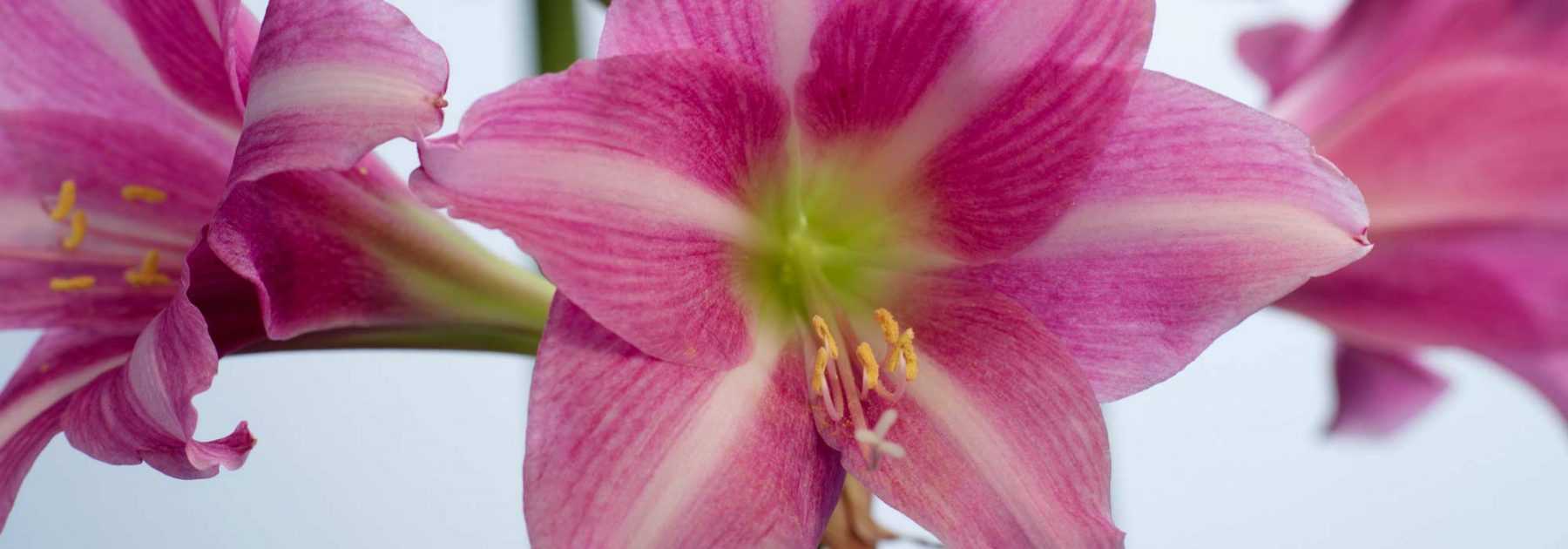
Amaryllis: How to Care for, Bloom and Rebloom
Enjoy their beautiful flowering for many years to come
Contents
Amaryllis, or Hippeastrum, are spectacular bulbous plants that produce large, vibrant flowers, often in red, pink or white. Well-known for their ability to brighten up indoor spaces during winter, these tender plants are perennial and can, with a little care, bloom again for several consecutive years. Discover all our tips for maintaining and getting your amaryllis to rebloom year after year!
→ Also listen to our audio podcast on the subject:
How to Care for Amaryllis?
Caring for amaryllis is relatively simple, but certain steps are essential to encourage beautiful flowering:
- Water regularly, but not excessively, allowing the compost to dry slightly between waterings. Too much water could cause the bulb to rot, so be careful not to let water stagnate in the saucer.
- Apply a little liquid fertiliser for flowering plants every two weeks during the growing period, especially when the stem and leaves are developing. Simply dilute the fertiliser in the watering water. This nutrient boost will help produce more abundant and higher-quality blooms.
Amaryllis flowers usually appear between 6 and 8 weeks after planting. However, you can slightly delay or speed up flowering by adjusting temperature and light exposure:
- To slow down flowering, place the plant in a slightly cooler room, around 16 to 18°C, and avoid direct light exposure.
- To speed up flowering, position the amaryllis in a warmer room, at about 18 to 22°C, ideally in a sunny spot.
Once the flowers have faded, cut the flower stems at the base to prevent the plant from wasting energy unnecessarily. However, leave the leaves intact and continue watering and fertilising moderately—the foliage is necessary for the bulb to store energy for future blooms.
How to Make Amaryllis Bloom Again?
After your amaryllis has flowered:
- Using secateurs, cut off the faded flowers and allow the leaves to develop.
- Continue watering regularly and apply houseplant fertiliser every two weeks. This is when the bulb replenishes itself to prepare for next year’s blooms.
- After 4 to 6 months, neglect your potted plants—leave them undisturbed for about 3 months in a sheltered spot, without light or watering, in a cool place: the bulbs need a dormant period in cool conditions before reflowering.
- Once this time has passed, you can then trim the withered leaves, repot in fresh potting compost, and begin a new growing cycle.
After the initial flowering, follow these key steps to encourage your amaryllis to bloom again:
- Remove faded flowers: As soon as the flowers wilt, use secateurs to cut the flower stems at the base, avoiding the leaves. These will continue to grow and are essential for replenishing the bulb’s energy.
- Continue watering and fertilising: Maintain regular but moderate watering, keeping the compost slightly moist without overwatering. Apply a potassium-rich houseplant fertiliser approximately every two weeks. During this growth phase, the bulb stores nutrients needed for next year’s blooms.
- Allow the bulb to enter dormancy: After about 4 to 6 months of active growth, the leaves will naturally yellow and wither, signalling the bulb’s preparation for dormancy. Gradually reduce watering and stop fertilising. Then, place the potted bulb in a cool, dark, and dry location (ideally between 10–15°C), such as a cellar or garage, for about 2 to 3 months. This rest period is crucial for encouraging the next flowering.
- Revive the bulb and repot: After dormancy, remove any completely dried leaves and repot the bulb in fresh, well-draining compost. Leave about one-third of the bulb above the soil surface to prevent rot.
- Restart a new cycle: Gradually resume watering to encourage new stem and leaf growth, and place the pot in a bright, temperate spot (18–22°C). Following these steps, your amaryllis should reflower within 6 to 10 weeks after waking the bulb.
By repeating this cycle each year, you can enjoy stunning amaryllis blooms year after year!

The case of garden-grown Amaryllis
Did you know that there are hardy amaryllis varieties, suitable for outdoor cultivation? This is the case, for example, with Amaryllis sonatini ‘White Rascal’, ‘Marrakech’ or ‘Balentino’, which are hardy down to -6 to -8°C. Classic, more tender amaryllis can also be planted in the ground, provided they are planted in spring after the last frosts and dug up in autumn to protect them from the cold. Here’s how to successfully grow amaryllis outdoors:
- Plant amaryllis bulbs in April or May, after the last frosts. Choose a sunny spot sheltered from the wind. A location that enjoys several hours of sunlight a day is ideal to ensure good growth and abundant flowering.
- Dig a hole deep enough to cover two-thirds of the bulb, leaving the top third above ground to prevent rotting. Make sure the soil is well-drained; if necessary, add some sand to improve drainage.
- Water regularly during the growing season, keeping the soil slightly moist but not waterlogged. Apply a flowering plant fertiliser every 2 to 3 weeks to encourage growth and flowering.
- In early autumn, as temperatures begin to drop, gradually reduce watering.
- If you’re growing a non-hardy amaryllis: before the first frosts, carefully dig up the bulbs. Clean them and let them dry for a few days. Then store them in a cool, dry, dark place (around 10 to 15°C), such as a cellar or garage, over winter. This rest period is essential for the bulbs to regenerate before the next planting season. The following spring, once the risk of frost has passed, you can replant the bulbs in the garden following the same steps.
- Subscribe!
- Contents

































